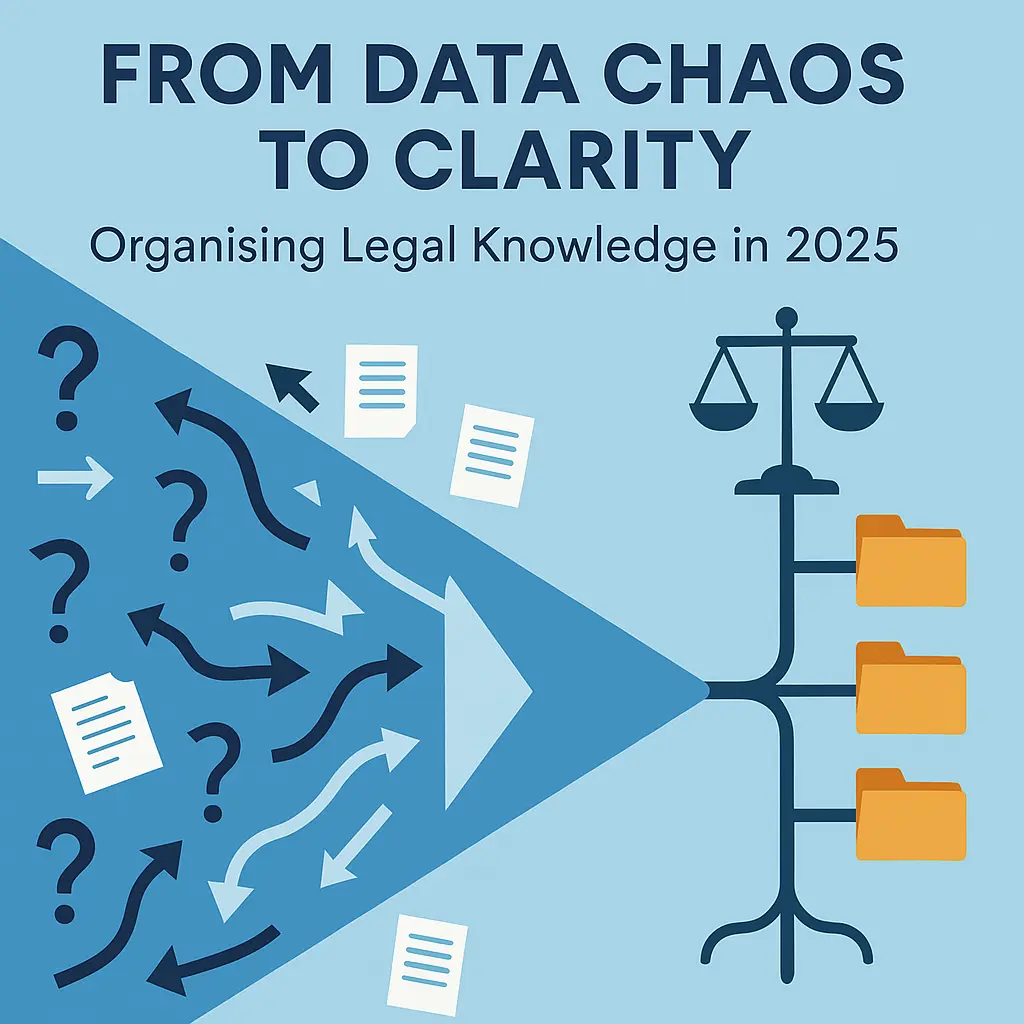
From Data Chaos to Clarity: Organising Legal Knowledge in 2025
Law firms are sitting on gold but it's buried in PDFs, emails, and shared drives.
The problem isn't that firms lack knowledge; it's that they can't find it, trust it, or reuse it quickly enough.
In 2025, knowledge management is shifting from librarianship to infrastructure.
The firms leading that shift are turning unstructured data into structured intelligence that powers drafting, due diligence, and decision-making.
Key Takeaways
- Knowledge chaos = lost hours. Lawyers spend up to 40% of their time searching for prior work.
- Infrastructure fixes disorder. Governance, metadata, and retrieval pipelines create clarity.
- AI readiness begins with discipline. Structured data fuels accuracy and compliance.
- Knowledge architecture ≠ storage. It connects, classifies, and controls insight.
- Qanooni insight: Clarity is a data-infrastructure outcome not a software feature.
The Problem: Knowledge Everywhere, Value Nowhere
Lawyers create enormous intellectual property daily opinions, templates, pleadings, contracts yet most of it disappears into digital noise.
Studies by the International Legal Technology Association (ILTA) show that lawyers spend nearly 35-40% of their time re-creating existing work.
That isn't inefficiency; it's information disorder.
Without structure, valuable insights stay hidden, and generative AI tools surface the wrong versions, undermining accuracy and client trust.
What Is Knowledge Architecture?
Knowledge architecture is the governed framework that organises, classifies, and secures a firm's information so AI tools can retrieve it accurately and compliantly.
This single definition line positions the blog for featured-snippet eligibility.
The Shift: From Repository to Architecture
The traditional knowledge repository — a folder hierarchy or SharePoint site — is no longer enough.
Modern firms are adopting knowledge architecture, a governed structure that treats every document as a data point.
A knowledge architecture combines:
- Metadata frameworks : tagging by matter type, client, jurisdiction, and confidentiality.
- Ontologies : shared legal definitions linking precedents, clauses, and outcomes.
- Retrieval infrastructure : vector search and AI pipelines optimised for legal language.
- Governance models : who can access, edit, and audit content.
Together, these elements transform static libraries into living, searchable ecosystems that feed directly into AI-assisted drafting and review tools.
Why 2025 Is the Pivotal Year
Three converging forces make 2025 the tipping point for knowledge management in law firms:
- AI adoption exposes weak data foundations. : Chatbots are only as good as the knowledge they draw from.
- Regulators are watching. : The ICO and SRA now expect explainability and audit trails for AI-assisted work.
- Clients are demanding provenance. : "Where did this clause come from?" is now a compliance question, not curiosity.
Firms investing in infrastructure now will meet these expectations with confidence instead of retrofitting controls later.
From Unstructured to Understood: The 4-Step Model
| Step | Focus | Outcome |
|---|---|---|
| 1. Centralise | Consolidate data sources within Microsoft 365 and DMS platforms | Single source of truth |
| 2. Classify | Apply consistent metadata and taxonomy across documents | Faster, accurate retrieval |
| 3. Govern | Enforce access, retention, and audit policies | Compliance by design |
| 4. Connect | Enable AI search and contextual retrieval layers | Firm-wide knowledge leverage |
The Hidden Cost of Data Chaos
Every disconnected repository adds risk.
A single mis-tagged precedent can lead to the wrong clause in a contract, or an outdated regulation cited in litigation.
Beyond time lost, unmanaged knowledge creates liability.
As LawNet UK highlighted in its 2025 Legal Tech Outlook, "Data confidence will separate firms that experiment with AI from those that deploy it at scale."
Across firms modernising their knowledge stacks, Qanooni research shows drafting efficiency improving by 32% and AI retrieval accuracy rising by 27% within six months of structured-data adoption.
Infrastructure: The Quiet Advantage
Infrastructure rarely gets headline credit, yet it powers every visible gain.
Firms with clear data lineage and governed retrieval are already reporting:
- 30% faster drafting cycles
- Reduced duplication of templates
- Improved compliance audit scores
- Higher partner confidence in AI-assisted output
This is the invisible ROI of knowledge architecture — productivity with provable trust.
How Qanooni Turns Knowledge into an Asset
Qanooni enables this transformation by combining data architecture with legal-grade governance:
- Data never leaves the firm's Microsoft 365 environment.
- Metadata pipelines ensure every document, clause, and precedent is indexed consistently.
- Search and retrieval leverage legal-specific embeddings to surface context, not just keywords.
- Audit trails and permissions maintain accountability under UK GDPR and SRA guidance.
Rather than storing knowledge, Qanooni structures it; creating clarity from chaos without compromising security.
The Outlook: Clarity as Competitive Edge
By 2026, "knowledge clarity" will be as strategic as profitability.
Clients will expect evidence that a firm's AI outputs trace back to validated, version-controlled sources.
Infrastructure-driven firms will answer that confidently; others will scramble to verify.
In the race toward digital maturity, clarity beats complexity.
Learn More
- Read the Qanooni data-infrastructure article
- Explore Beyond Chatbots: How Legal AI Becomes an Extension of the Lawyer
- Review AI Risk and Regulation: What UK Lawyers Need to Know Before 2026
Frequently Asked Questions
What is knowledge architecture in a law firm?
It's the governed framework that organises, classifies, and secures legal knowledge so AI tools can use it accurately and compliantly.
Why is 2025 critical for knowledge management?
Because regulators, clients, and AI adoption are converging — making structured data essential for efficiency and compliance.
How does Qanooni help firms reduce data chaos?
By centralising and classifying firm data within Microsoft 365, adding metadata pipelines, and embedding governance into every retrieval.